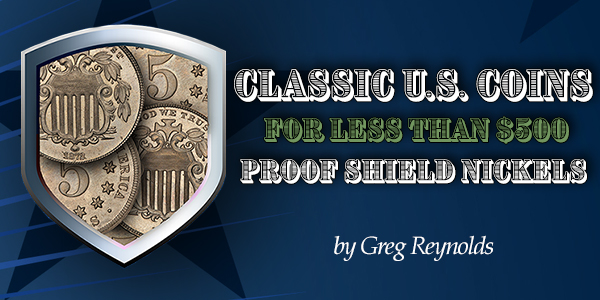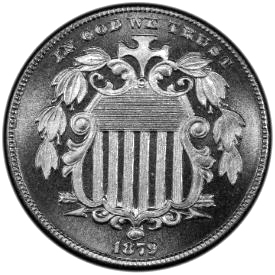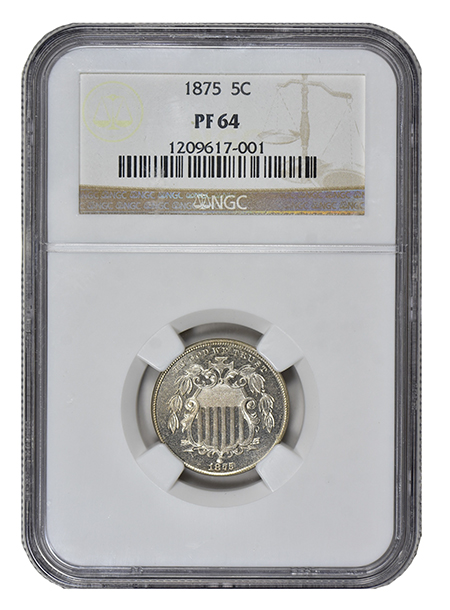
A Weekly CoinWeek Column by Greg Reynolds …..
Analysis regarding scarce coins, markets, and coin collecting #349
The emphasis here is on PCGS- or NGC-certified, Proof-64 or -63 ‘No Rays’ Shield Nickels dating from 1867 to 1883, Choice Proofs. This is the 23rd installment in a series on classic U.S. coins that cost less than $500 each, and the first in this series to focus upon Proof coins, which are specially made and elaborate.
This is the third in this series about nickels. In June 2015, Three Cent Nickels (1865-89) were covered, and Buffalo Nickels (1913-38) were discussed in December 2014.
Shield nickels minted during 1866 and part of 1867 feature rays on the reverse (back of the coin). The rays are components of the reverse design. These rays are readily apparent without magnification. The ‘without rays’ or ‘No Rays’ type dates from 1867 to 1883. So, all but two issues of Shield Nickels are of the ‘No Rays’ type.
“There is very little downside to buying Proof-64 Shield nickels now,” declares John Albanese. “In March 1980, Proof-64 Shield nickels were selling for six times current prices, now like 16 cents on the dollar! In 1989 or 1990, they got to only about half of their March 1980 levels, but still three times current levels. They are probably down 30% since 2007,” John adds. Albanese is the founder and president of Certified Acceptance Corporation (CAC).
Values of business strike Shield nickels have fallen, too. Given current price levels, I suggest that Proofs are better values than MS-64 grade, ‘No Rays’ Shield nickels (1867-83), from a logical perspective. It would be exciting to nearly complete a set of ‘No Rays’ Shield nickels, all in Proof format.
Proofs & Business Strikes
Although it is not practical to explain Proof coins here, some remarks about the differences between Proofs and business strikes are appropriate, as it is hoped that this discussion is meaningful to collectors of all knowledge-levels. Business strikes were made by ordinary methods, with the standard technology employed at the time for mass production of coins.
For multiple reasons, it is not logical to refer to business strikes as circulation strikes.
During the history of U.S. coinage, there are many business strikes that were not made for circulation. Coins in so-called ‘original mint sets’ are examples, as are some (though not all) commemorative coins. It is also likely that there were many business strikes made for political reasons, sometimes without announcements or detailed records. Business strike coins were not only used as money; quite a few business strike coins served other purposes.
It is known that collectors, dealers and tourists obtained coins directly from the Philadelphia Mint during the 19th century. Hundreds of these were gem quality business strikes, which were clearly not placed into general circulation.

Shield nickels: Business Strike (left) and Proof Strike (right).
Proofs were specially made, with the idea that they appear much different from business strikes. The preparation of the dies and the production process were different. Proofs and business strikes frequently seem like different species of coins.
All 19th-century Proofs have or had some kind of very reflective surfaces. Not all have mirrored fields. In many cases, blanks were prepared specially for the minting of Proof coins, as they were buffed or otherwise modified. Design elements on Proofs form in manners that are different from corresponding design elements on business strikes.
As nickel is harder than other metals typically employed for coinage, it was more difficult in the 19th century to make Proofs of nickel coins, even though nickels are just 25% nickel in composition. The criteria for judging nickels to qualify for Proof status are looser and more liberal than such criteria for 19th-century silver or gold coins.
During most years that Shield Nickels were produced, business strikes are frosty and lustrous, while Proofs have medium reflective surfaces and lack luster. The overall dynamics of Proof and business strike nickels are different in ways that are very hard to explain.
For some Shield nickels, especially those of 1880, a business strike is worth more than a Proof with the same numerical grade assigned by the same grading service. When I was an active coin collector for many years before becoming an adult, among coin enthusiasts whom I knew, it was unthinkable for a collector to pay more for a business strike than for a Proof of the same type and date.
Collectors in past eras often mixed Proof and business strikes in the same sets. It is relevant that some of the greatest collections of all time featured mixed sets, including the Eliasberg and Norweb Collections.
Of course, collectors should and will form their own opinions regarding Proofs, business strikes, and the premiums to be paid for Proofs or business strikes. In my opinion, except for superb Barber coins, it is generally not a good idea to pay more for a business strike than for a Proof 19th-century U.S. coin of the same type, date and numerical grade.
Also, only Philadelphia Mint coins relate to this discussion. Before 1912, all U.S. nickel coins were struck at the Philadelphia Mint.
Someone who collects Proof Shield nickels does not have to think about premiums for business strikes. The theme here is the suggestion that motivated beginning or intermediate-level collectors assemble a set of Proof Shield nickels of the second type, without rays on the reverse. The business strikes of 1879 to 1881 are particularly expensive, while their Proof counterparts are not very expensive.
Cameo Proofs?
When the recesses of the dies were specially treated with a particular kind of chemical compound for stylistic purposes, a thick white substance characterizes the design elements on Proofs struck from such dies. This substance becomes integrated with the metal and part of coins. If the contrast between the ‘white’ design elements and the nearby mirrored fields is very noticeable, then a coin may be designated at NGC or PCGS as having a “Cameo” contrast. If the contrast is very bold, especially with thick white design elements and lively mirror fields, then a “Deep Cameo” at PCGS or an “Ultra Cameo” designation at NGC may be noted on the printed label (‘insert’) inside the holder and in the population data.
 When Cameo Proofs tone, the white elements may turn tan, beige, russet, blue or orange. The toning of white design elements does not preclude ‘Cameo’ designations. Although coins with cameo designations are often cool, is it a good idea to pay large premiums for coins with cameo designations?
When Cameo Proofs tone, the white elements may turn tan, beige, russet, blue or orange. The toning of white design elements does not preclude ‘Cameo’ designations. Although coins with cameo designations are often cool, is it a good idea to pay large premiums for coins with cameo designations?
Higher market levels for coins with cameo designations encourage dipping, the immersion of coins in acidic solutions, which artificially brightens them. Proof coins will often, though not always, have more of a cameo contrast after being dipped.
Neat natural toning that gradually formed over decades is frequently destroyed by dipping and metal on the surfaces is stripped as well. Characteristics used to track pedigrees, especially dimensions of toning, are often destroyed by dipping, too. A coin becomes lighter in weight and color after being dipped. Usually, the degree of originality of a coin is dramatically reduced by dipping. There are, though, collectors who prefer very apparently dipped coins, and dipping sometimes removes harmful substances.
Controversies regarding dipping are beside the present topic. An immediate point here is that collectors should not pay more than modest premiums for coins with “Deep” or “Ultra” cameo contrasts, which are very ambiguous anyway. The same grading service may attach such a designation to the same coin during some submissions though not during others. The same Proof coin may be submitted multiple times before receiving a “Deep” or “Ultra” designation.
Collecting ‘By Date’
Earlier this month, on September 4, the firm GreatCollections sold a ‘No Rays’ 1867 nickel that is NGC-certified as Proof-63 for $291.38 USD. In June 2015, Heritage sold a PCGS-certified Proof-63 ‘No Rays’ 1867 for $305.50.
Regarding the auction and Internet-sale results listed below, I have not seen the coins mentioned and I am not, in any way, expressing agreement with the respective certified grades. Collectors should view many coins and discuss grading criteria with experts.
Almost every collector occasionally acquires a coin that turns out to be a disappointment. This is part of the realities of collecting.
Importantly, there are dealers and collectors who will buy coins in PCGS and NGC holders without carefully considering the coins inside. They are literally collecting or dealing “in the holders”.
Even if most relevant experts in the nation thought that a particular certified grade was wrong, there would still be many buyers who would desire the holder where such a coin resides. Opinions regarding the relative consistency of PCGS or NGC notwithstanding, it is a fact that buying PCGS- and NGC-certified Shield nickels involves much less risk, on average, than purchasing similar coins that are not PCGS- or NGC-certified. It is impossible to eliminate all risk regarding any aspect of life.
1868-76
For each date from 1868 to 1876, PCGS- or NGC-certified Proof-64 Shield nickels may probably be found and purchased for less than $500 each. In the event that a collector cannot find an appealing, certified Proof-64 of one of these dates for less than $500, a Proof-63 piece of that date could almost certainly be obtained for considerably less than $500.
In March 2016, Heritage sold a PCGS-graded 64 1868 for $446.50. In November 2015, GreatCollections sold a PCGS-certified Proof-64 1869, with a sticker of approval from CAC, for $346.50.
During May 2016, Heritage sold a NGC-certified Proof-64 1870, with a CAC sticker, for $470. Images suggest that it might be a really neat coin, with appealing russet and green tones, in a fairly old NGC holder.
 In January 2015, GreatCollections sold a PCGS-certified Proof-64 1871 for $489.50. On July 29, 2016, Scotsman Coins sold a PCGS-certified Proof-64 1872 for $368.
In January 2015, GreatCollections sold a PCGS-certified Proof-64 1871 for $489.50. On July 29, 2016, Scotsman Coins sold a PCGS-certified Proof-64 1872 for $368.
Although business strikes come with 1873 ‘Close 3‘ and 1873 ‘Open 3’ dates, it is generally believed that all Proof 1873 Shield nickels have a ‘Close 3’ numeral in the year. In July 2015, Stack’s-Bowers auctioned a NGC-certified Proof-64 1873 for $381.88. In May 2016, GreatCollections sold a PCGS-certified Proof-65 1873 for $463.10.
Finding an 1874 is easy. Though not as easy, finding a Proof 1875 and an 1876 is not difficult. Just a few days ago, GreatCollections sold a NGC-certified Proof-64 1875 for $344.30. In July 2015, Stack’s-Bowers auctioned a PCGS-certified Proof-64 1876 for $440.63.
1877-78
It is generally believed that no business strikes were made in 1877 and 1878. U.S. Mint records seem to indicate that these are “Proof-only” issues. In multiple contexts, Q. David Bowers has pointed out that some 1878 Shield Nickels do not have the characteristics of Proofs.
“It is interesting to debate whether [some 1878 Shield nickels] should be called Proofs because they were called that by the Mint,” Q. David Bowers remarks in his Guide Book of Shield and Liberty Head Nickels (2006), “or whether they should be called Uncirculated for they appear to be” business strikes (Bowers, 116).
I, too, am not convinced that all 1877 and 1878 nickels are Proofs, though a non-Proof is not necessarily a business strike. The striking characteristics of these tend to vary and are distinct from earlier Proof Shield nickels. If some 1878 or 1877 Shield nickels are not Proofs, those may be difficult to classify or explain.
Regardless of whether all truly qualify as Proofs, all 1877 and 1878 nickels are likely to continue to be certified as Proofs by PCGS and NGC. Moreover, it does seem that fewer than 1,000 1877 Shield nickels and fewer than 2,000 1878 Shield nickels survive. These are scarce, and are demanded by both collectors of Proofs and collectors of sets of mostly business strikes. It would not be sensible to seek to acquire an 1877 or an 1878 Shield nickel for less than $500.
1879-83
As for the 1879/8 overdate, the 1879 ‘normal date,’ the 1880 and the 1881, these are slightly ‘better dates,’ presumably scarcer than earlier Proofs. Even so, it is practical to acquire Proofs of these dates that are certified as grading 64 or 63 for less than $500 each. In September 2015, GreatCollections sold a PCGS-certified Proof-64 1880 for $462. On June 1, 2014, the Goldbergs sold a PCGS-certified Proof-64 1881 for about $400.
The 1882 and the 1883 are among the least scarce Shield nickels in Proof format. Over a span of two or three years, collectors may choose among many PCGS- or NGC-certified Proof-64 coins available.
Concluding Remarks
Except for the 1877 and the 1878, a set of all ‘No Rays’ Proof Shield nickels (1867-83) may be completed without spending more than $500 for any one coin, with most coins being PCGS- or NGC-certified as Proof-64, and a small number certified as Proof-63. In some cases, a “Proof-63” coin may be more desirable than a coin of the same type and date that is certified as “Proof-64” by the same grading service. It’s a good idea to seek advice and to learn at least a little about grading.
As for the 1866 and 1867 ‘With Rays,’ these cannot be obtained in Proof format for less than $500. So, collectors may buy business strikes. A PCGS- or NGC-graded MS-63 1866 could be found for less than $500.
A PCGS- or NGC-graded 1867 ‘With Rays’ nickel in the range of AU-55 to MS-62 could surely be purchased for less than $500. In August 2016, Stack’s-Bowers auctioned a PCGS-graded AU-58 coin for $282.
Therefore, without spending as much as $500 on any one coin, with business strikes of the two issues of the ‘With Rays’ type and Proofs of every issue of the ‘No Rays’ type, a set of Shield nickels could be completed, except for the 1877 and the 1878. It would be fun and exciting to assemble such a set. These are the nation’s first five cent nickel coins.
© 2016 Greg Reynolds
Recent Articles in This Series on Classic U.S. Coins for Less Than $500 Each:
Braided Hair Half Cents | Matron Head Large Cents | Classic Head Half Cents | Draped Bust Half Cents | Classic Head Large Cents | Gem Early Lincoln Cents | Indian Head Half Eagles | Two Cent Pieces | Three Cent Nickels | Indian Head Quarter Eagles | Copper-Nickel Indian Cents | Standing Liberty Quarters | Walking Liberty Half Dollars




